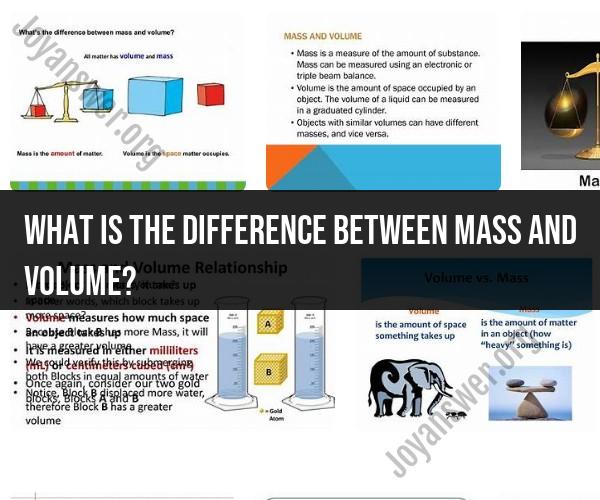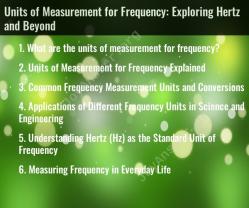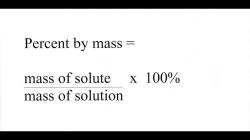What is the difference between mass and volume?
Mass and volume are two fundamental properties used to describe matter, but they represent different aspects of an object's characteristics:
Mass:
- Mass refers to the amount of matter in an object. It is a measure of how much stuff (atoms and molecules) is contained within an object.
- The standard unit of mass in the International System of Units (SI) is the kilogram (kg). Smaller units, such as grams (g) and milligrams (mg), are also commonly used.
- Mass is a scalar quantity, meaning it has magnitude but no direction.
- Mass is an intrinsic property, meaning it remains the same regardless of the object's location or the presence of gravity.
Volume:
- Volume refers to the amount of space occupied by an object. It is a measure of the three-dimensional extent of an object.
- The standard unit of volume in the SI system is the cubic meter (m³). However, depending on the context, other units like liters (L) or cubic centimeters (cm³) are frequently used.
- Volume is a scalar quantity and does not have a direction.
- The volume of an object can change based on its shape and the conditions (e.g., temperature and pressure) under which it is measured.
In summary, mass quantifies how much matter is present in an object, while volume quantifies the amount of space the object occupies. These properties are often used together to calculate an object's density, which is the mass per unit volume and is expressed in units like kilograms per cubic meter (kg/m³) or grams per cubic centimeter (g/cm³).
Mass vs. Volume: Differentiating Two Fundamental Physical Properties
Mass and volume are two fundamental physical properties that are often confused. Mass is the amount of matter in an object, while volume is the amount of space an object takes up.
Mass is measured in units such as grams, kilograms, and pounds. Volume is measured in units such as cubic centimeters, cubic meters, and gallons.
One important difference between mass and volume is that mass is a constant property, while volume can change. For example, the mass of an ice cube is the same as the mass of the water it melts into, but the volume of the ice cube is greater than the volume of the water. This is because ice is less dense than water.
Another important difference between mass and volume is that mass is affected by gravity, while volume is not. For example, an astronaut on the moon would have the same mass as on Earth, but their weight would be less because the moon has less gravity.
Exploring the Distinctions Between Mass and Volume in Science
Mass and volume are important concepts in many different scientific fields, including physics, chemistry, and biology.
In physics, mass and volume are used to calculate density, which is a measure of how much mass is contained in a given volume. Density is an important property of materials, and it can be used to identify and classify different substances.
In chemistry, mass and volume are used to measure the amount of reactants and products in chemical reactions. Mass and volume are also used to calculate the concentration of solutions, which is the amount of solute dissolved in a given volume of solvent.
In biology, mass and volume are used to measure the growth and development of organisms. They are also used to measure the amount of food and water consumed by organisms.
Mass and Volume: Key Concepts in Measurement and Chemistry
Mass and volume are two key concepts in measurement and chemistry. They are used to calculate many other important properties, such as density, concentration, and energy.
Here are some examples of how mass and volume are used in measurement and chemistry:
- Density: Density is calculated by dividing the mass of an object by its volume. For example, the density of water is 1 gram per cubic centimeter.
- Concentration: The concentration of a solution is calculated by dividing the mass of solute by the volume of solution. For example, the concentration of a 10% salt solution is 10 grams of salt per 100 grams of solution.
- Energy: The energy of a system can be calculated using the equation E = mc^2, where E is energy, m is mass, and c is the speed of light.
Mass and volume are essential concepts for understanding and measuring the physical world. They are used in a wide range of scientific fields, including physics, chemistry, and biology.












